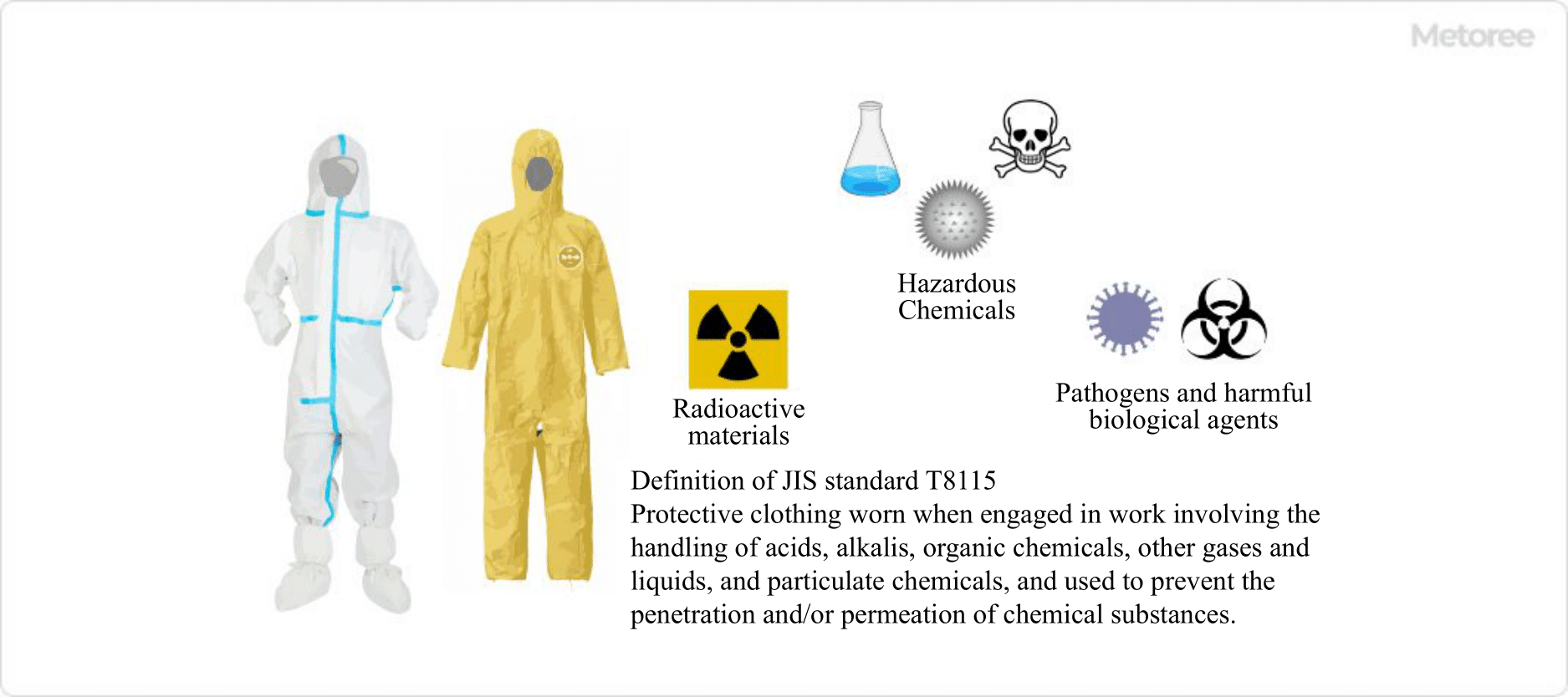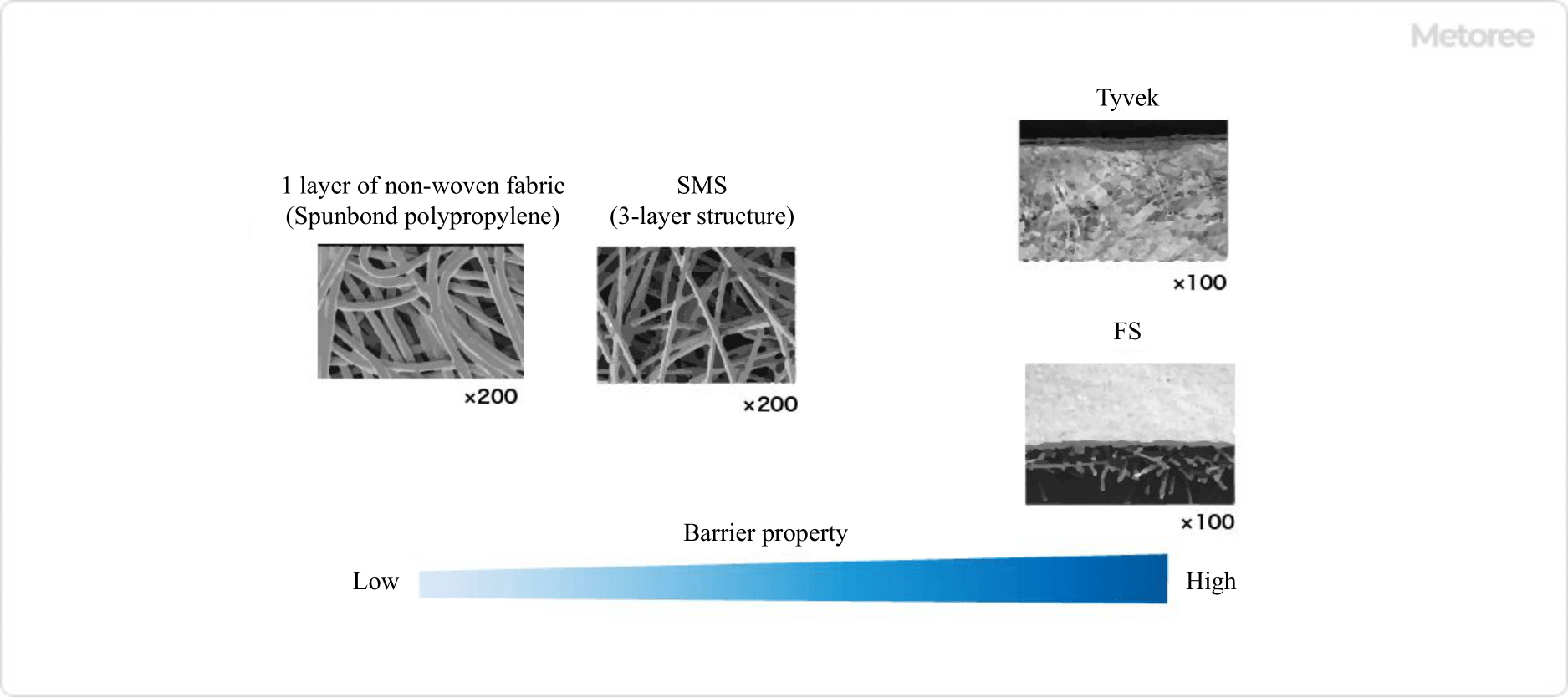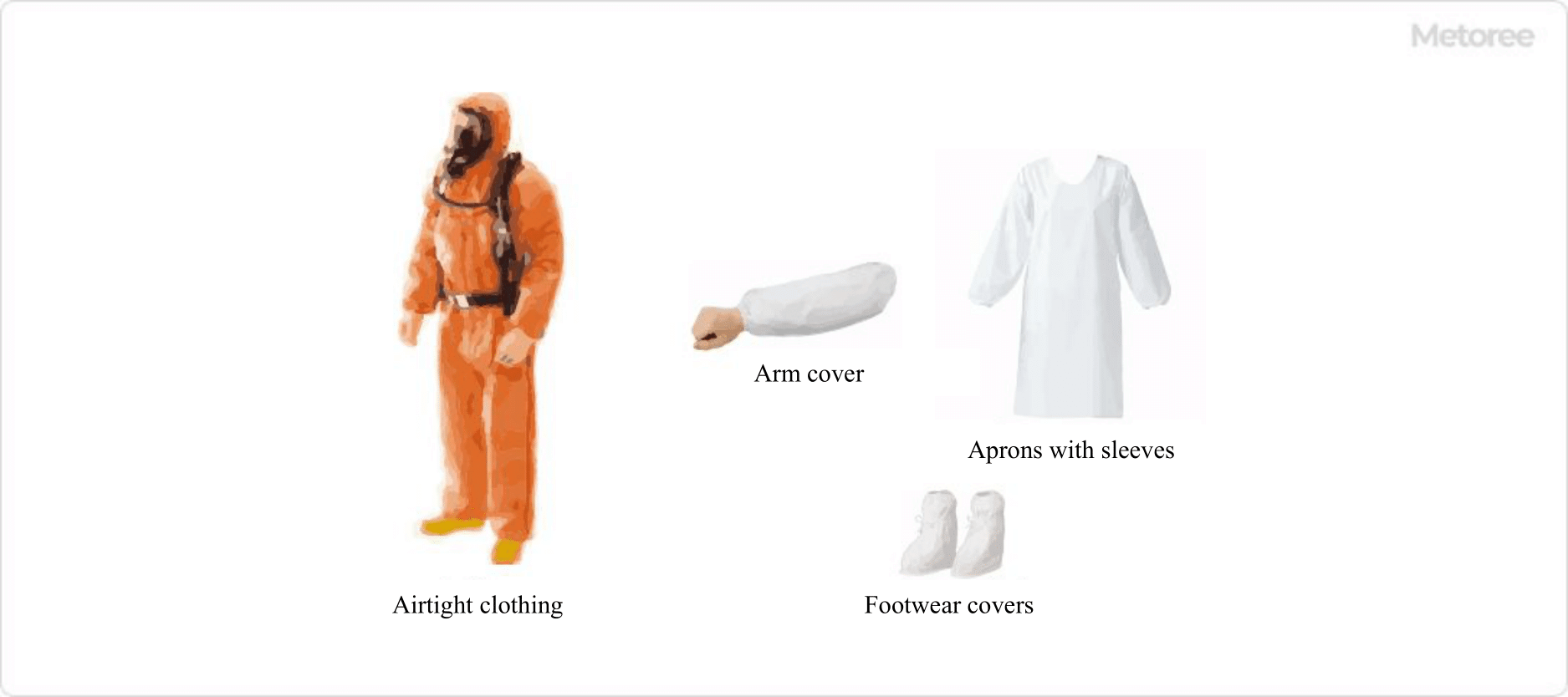All Categories
History







This section provides an overview for chemical & biological protective clothing as well as their applications and principles. Also, please take a look at the list of 7 chemical & biological protective clothing manufacturers and their company rankings. Here are the top-ranked chemical & biological protective clothing companies as of January, 2026: 1.UNITIKA LTD., 2.UVEX ARBEITSSCHUTZ GmbH, 3.3M.
Table of Contents
Categories Related to Chemical & Biological Protective Clothing

Figure 1. Overview of protective clothing
Chemical protective clothing is protective clothing worn to ensure the safety of workers and protect their health when handling hazardous chemical substances.
Protective clothing should be worn when engaged in work involving the handling of acids, alkalis, organic chemicals, and other gaseous, liquid, and particulate chemical substances (hereinafter referred to as chemical substances).
Unlike ordinary clothing, the surface gaps are very small and smooth. The materials used also have extremely low permeability to organic solvents. Although originally manufactured to protect against chemical substances, it is also used to protect against biological and radioactive materials due to its high particulate protection effectiveness.
The main uses of chemical protective clothing are in workplaces where chemical substances are handled, in the event of a disaster caused by nuclear, biological, or chemical substances, and in workplaces where hazardous substances must be disposed of.
Examples of past large-scale disasters include the following:
Chemical protective clothing is usually used to protect against harmful substances to the human body, but it can also be used to protect workers from contamination.
Examples include metalworking industries where grease and soot stains are common, and painting and printing industries where paint and ink are used.
Other applications include clean rooms in regenerative medicine research, where protective clothing is used to protect cells and drug products from bacteria that may be attached to the worker's body.

Figure 2. Various materials used in protective clothing
Chemical protective clothing is made of a variety of textile materials, including non-woven fabrics, SMS, FS, and Tyvek®. It is very important to wear protective clothing of the appropriate standard for the intended event.
This product is made of spunbond polypropylene. The single-layer structure of spunbonded polypropylene fabrics allows for a large number of voids between fibers. Although the barrier property is somewhat inferior, it is inexpensive and suitable when cost is important. It is sufficient for light soiling.
SMS polypropylene is used for this product. It has a three-layer structure consisting of spunbonded, meltblown, and spunbonded materials. It is characterized by strong abrasion resistance and a cloth-like feel. Although relatively inexpensive, it is resistant to abrasion and light soiling, and has a high barrier effect against dust and droplets.
This product uses a film laminate. It has a structure in which a thin film material is attached to the surface of polypropylene, spun-bonded nonwoven fabric, or the like. It has high barrier properties against dirt and dust, and excellent waterproofing properties, making it suitable for work in watery areas.
Tyvek is a special material unique to DuPont, consisting of continuous microfibers of high-density polyethylene (0.5~10 microns) bonded together by heat and pressure, which provides excellent barrier properties against particles of 1 micron or less. Two-layer protective clothing with polymer coating is also available.

Figure 3. Full Body Chemical Protective Clothing and Partial Chemical Protective Clothing
There are two types of chemical protective clothing: full body chemical protective clothing, which protects the entire body or a large part of the body, and partial body chemical protective clothing, which protects a part of the body.
Full-body chemical protective clothing can range from airtight suits with self-contained breathing apparatuses inside, to full-body suits that are sealed against liquids and chemical mists.
Partial chemical protective clothing includes aprons, footwear covers, lab coats, arm covers, and smogs.
*Including some distributors, etc.
Sort by Features
Sort by Area

3M Company was founded in 1902 and is headquartered in St. Paul, Minnesota. 3M provides diversified technology services globally. 3M operates through four segments: Safety and Industrial, Transportation and Electronics, Health Care, and Consumer. The Safety and Industrial segment offerings include industrial abrasives, masking, and natural and color-coated mineral granules for shingles. The Transportation and Electronics segment offerings include ceramic solutions, light management films, and electronics assembly solutions. The Healthcare segment offerings include wound care, dentistry and orthodontia solutions, and filtration and purification systems. The Consumer segment offerings include consumer bandages, picture hanging, and stationery products.

DuPont de Nemours, Inc., commonly shortened to DuPont, is an American multinational chemical manufacturer headquartered in Wilmington, Delaware, and established in 1802. The company offers adhesives and coatings for electronic components, commercial inkjet inks for printing solutions, surfacing materials and insulating foam sealants for building constructions, chromatography resins for protein purification, as well as lubricants and fluids for various electronic component applications. They also provide specialty enzymes and proteins for food production, thermal management materials, and microbial control products for industrial hygiene. DuPont serves various industries, including automotive, building and construction, energy, packaging and printing, as well as water management.

Uvex Arbeitsschutz GmbH, started in 1926 and situated in Furth, Germany, is a manufacturer of a large array of personal protective equipment. The company manufactures safety glasses, safety helmets, safety gloves, and safety shoes. It also fabricates respiratory protection, hearing protection, functional underwear, and disposable protection coveralls. Its safety glasses feature lightweight safety spectacles with contoured anti-fog and scratch-resistant lenses for a great fit on narrow or wider faces. It serves various industries, including automotive, construction, health care, metalworking, and service providers.

UNITIKA LTD., founded in 1889 and headquartered in Osaka, Japan, is a manufacturer specializing in polymers, advanced materials, fibers, and textiles. The company operates several divisions, including those specialized on nylon and polyester films, engineering plastics, spunbond and spunlace fabrics, as well as activated carbon fibers, and glass fibers. It serves various industries, providing materials for a range of applications, from automotive and civil engineering to medical and daily use products.

Dräger, established in 1889, and headquartered in Lübeck, Germany, is a manufacturer and supplier of advanced safety and medical technology products. They offer a range of solutions, including gas detection systems, respiratory protection equipment, patient monitoring systems, ventilators, and anesthesia machines, which are designed for industries such as oil and gas, chemical, firefighting, healthcare, and mining. Dräger is certified with ISO 9001 for quality management and ISO 13485 for medical devices.


Saint-Gobain in Japan, established in 1917 and headquartered in Tokyo, Japan, is a manufacturer and distributor of materials and solutions for construction, mobility, healthcare, and various other industrial applications. The company's product portfolio includes glass ceramics, abrasive products, performance plastics, glass wool, and automotive glass. These products are applied in various industries, including automotive, aeronautical, healthcare, defense, and the food and beverage industry. The company holds both ISO 9001 and ISO 14001 certificates, as well as an OHSAS 18001 certificate for quality and EHS (Environmental Health and Safety) systems.
Ranking as of January 2026
Derivation Method| Rank | Company | Click Share |
|---|---|---|
| 1 | UNITIKA LTD. |
36.0%
|
| 2 | UVEX ARBEITSSCHUTZ GmbH |
20.0%
|
| 3 | Dräger |
16.0%
|
| 4 | 3M |
12.0%
|
| 5 | Toray Industries, Inc. |
8.0%
|
| 6 | Saint-Gobain in Japan |
8.0%
|
Derivation Method
The ranking is calculated based on the click share within the chemical & biological protective clothing page as of January 2026. Click share is defined as the total number of clicks for all companies during the period divided by the number of clicks for each company.Number of Employees
Newly Established Company
Company with a History
*Including some distributors, etc.
*Including some distributors, etc.
| Country | Number of Companies | Share (%) |
|---|---|---|
 United States of America
United States of America
|
2 | 66.7% |
 Germany
Germany
|
1 | 33.3% |
119 products found
119 products
Nikko Bussan Co., Ltd.
240+ people viewing
Last viewed: 1 day ago
■Excellent chemical resistance performance Demonstrates high barrier properties against inorganic chemicals. ■Seam tape processing Protected by li...
5 models listed
Nikko Bussan Co., Ltd.
190+ people viewing
Last viewed: 1 day ago
■Excellent moisture permeability and liquid protection Waterproof and breathable film provides comfort and protection against liquid and particulat...
5 models listed
Nikko Bussan Co., Ltd.
200+ people viewing
Last viewed: 13 hours ago
■Excellent flame retardant performance Even if it ignites, it will self-extinguish when you move away from the source of the fire, preventing the f...
5 models listed
Nikko Bussan Co., Ltd.
190+ people viewing
Last viewed: 4 hours ago
■Excellent moisture permeability and liquid protection Waterproof and breathable film provides comfort and protection against liquid and particulat...
5 models listed
Yagyu Shokai Co., Ltd.
410+ people viewing
■Features ・Chemical-resistant chemical boots made of steel plates to prevent stepping on, suitable for hazmat work, etc. - Chemical protection boo...
Yagyu Shokai Co., Ltd.
370+ people viewing
Last viewed: 10 hours ago
■Features ・The sole of the shoe has a built-in plate to prevent stepping on it, providing excellent safety. - The soles have excellent oil resista...
Nikko Bussan Co., Ltd.
180+ people viewing
Last viewed: 1 day ago
■Features With convenient pocket ■Specifications ・Left chest and right waist back pockets ・Elastic/hood, cuffs, hem, back waist ・Zipper cover w...
5 models listed
Yagyu Shokai Co., Ltd.
360+ people viewing
Last viewed: 1 day ago
■Features - Boots that comply with JIS T8117 chemical protection boots. - Recommended for chemical protection measures, dioxin, PCB exposure, and s...
Nikko Bussan Co., Ltd.
170+ people viewing
Last viewed: 1 day ago
■Features adjustable drawstring hood ■Specifications ・Left chest and right waist back pockets ・Elastic/cuffs ・Hood part rope string ・Anti-stat...
5 models listed
Nikko Bussan Co., Ltd.
210+ people viewing
Last viewed: 21 hours ago
■Features Separate type jumper for easy movement. Please use it when partial protection is required. ■Specifications ・Front right pocket, front z...
5 models listed
Dräger
580+ people viewing
Last viewed: 43 minutes ago
■Features CPS7900 is an airtight internal respiratory protective suit designed for use under harsh conditions. Airtight protective clothing that pr...
Dräger
440+ people viewing
Last viewed: 10 hours ago
■Features Light and comfortable to wear, the Dräger SPC4X00 occlusive protective suit protects against extremely fine particles and powders as well...
Dräger
470+ people viewing
Last viewed: 18 hours ago
■Features The Dräger CPS5900 is a limited-use gas-tight chemical protective suit ideal for handling hazardous materials. In situations where comple...
Dräger
370+ people viewing
■Features The Dräger CPS6800 is a chemical protective suit ideal for handling hazardous materials at extremely low temperatures and low concentrati...
Nikko Bussan Co., Ltd.
160+ people viewing
Last viewed: 22 hours ago
■Excellent dust collection performance 99.9% collection efficiency for particles larger than 3 µm ■Durability with excellent breathability Highly ...
5 models listed
Dräger
350+ people viewing
Last viewed: 21 hours ago
■Features The Dräger CPS6900 is the chemical protective suit most suitable for applications requiring protection against extremely cold substances ...
Nikko Bussan Co., Ltd.
160+ people viewing
■Comfortable to wear Lightweight and flexible fabric material provides more comfort. ■Excellent dust resistance and high breathability Demonstrate...
5 models listed
GUARDNER Corporation
330+ people viewing
■Summary A chemical-resistant apron that protects workers from chemicals at sites where chemicals are used. The fabric with conductive thread is tr...
Nikko Bussan Co., Ltd.
160+ people viewing
■Comfortable to wear Lightweight and flexible fabric material provides more comfort. ■Excellent moisture permeability and liquid protection Waterp...
5 models listed
GUARDNER Corporation
360+ people viewing
Last viewed: 22 hours ago
■Summary A kappo-gi type chemical-resistant apron that protects workers from chemicals at sites where chemicals are used. The fabric with conductiv...
GUARDNER Corporation
230+ people viewing
Last viewed: 10 hours ago
■Features Arm covers that protect workers from chemicals at sites where chemicals are used. The fabric with conductive thread is treated with olefin.
Kokugo Co., Ltd.
400+ people viewing
Last viewed: 14 hours ago
Chemical suit CS-1 type without ventilation structure LL ■Features ・Excellent flexibility, easy to move and safe. - Excellent chemical resistance...
GUARDNER Corporation
440+ people viewing
Last viewed: 2 hours ago
■Features Side magic tape detachable specification
Nikko Bussan Co., Ltd.
390+ people viewing
Last viewed: 1 day ago
■Features Separate pants for easy movement. Please use it when partial protection is required. ■Specifications ・Back right hip pocket ・Elastic/c...
Nikko Bussan Co., Ltd.
180+ people viewing
Last viewed: 21 hours ago
■Comfortable to wear Lightweight and flexible fabric material provides more comfort. ■Heat protection clothing made of two types of materials By i...
5 models listed